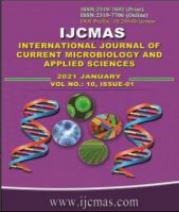


 National Academy of Agricultural Sciences (NAAS)
National Academy of Agricultural Sciences (NAAS)

|
PRINT ISSN : 2319-7692
Online ISSN : 2319-7706 Issues : 12 per year Publisher : Excellent Publishers Email : editorijcmas@gmail.com / submit@ijcmas.com Editor-in-chief: Dr.M.Prakash Index Copernicus ICV 2018: 95.39 NAAS RATING 2020: 5.38 |
During present studies colony record of Apis mellifera under stationary condition was recorded minimum (3.30 bee frames/conoly) in First fortnight of November 2019 and maximum (8.30 bee frames/ colony) in second fortnight of January 2020. Brood area was significantly low (1160.34 cm2/colony) in second fortnight of October 2019 and high (4013.67 cm2/colony) in first fortnight of January 2020. Pollen area was minimum (345.0 cm2/colony) in first fortnight of November 2019 and maximum (1720.71cm2/colony) in first fortnight of February 2020. The honey store was observed maximum (1660.50gm/colony) in second fortnight of January 2020. No incidence of EFB disease in Apis mellifera was observed from first fortnight of August to first fortnight of September 2019 and first fortnight of November 2019 to first fortnight of February 2020. The incidence of EFB was found Maximum at 16.0 percent during study period in the first fortnight of October 2019. Incidence of EFB was significantly negative association with colony strength (r= -0.522) and brood area (r= -0.627). The incidence of European foulbrood was found positively correlated with temperature (r= 0.341), and negatively correlated with rainfall (r= -0.144) and relative humidity (r= -0.494). Sac brood incidence was reported minimum (2.0%) in second fortnight of July 2019 and maximum (7.30%) in second fortnight of February 2020. No incidence of sac brood was found from first fortnight of August 2019 to second fortnight of January 2020. The incidence of Sac brood disease was found significantly negative correlated with brood area (r= -0.560) and relative humidity being non-significant. Also the incidence of Sac brood disease shows positively correlated with colony strength, average temperature and rainfall, though non-significant.
 |
 |
 |
 |
 |